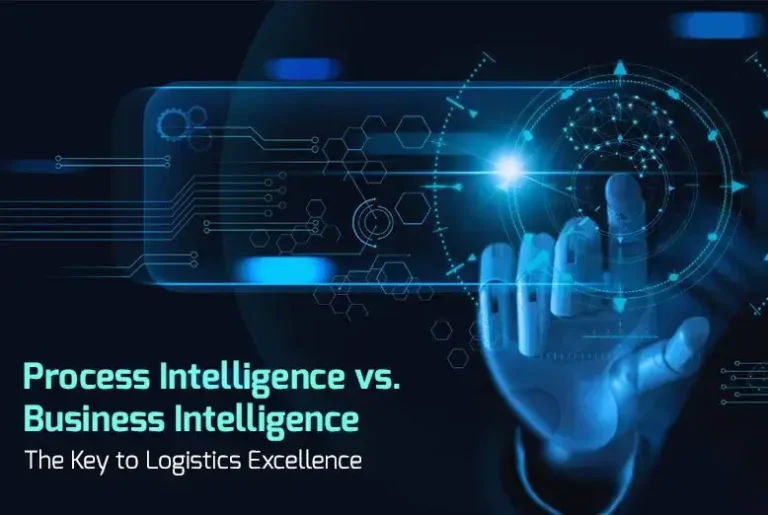Suppose you buy a package online. You monitor it at every stage—when it’s shipped from the warehouse when it’s moving, and when it arrives at your doorstep. Now consider the company that is shipping your package. How do they ensure that it arrives on time, at the minimum cost, and without errors? The solution is in Process Intelligence and Business Intelligence. These two robust tools enable logistics companies to think smarter and smarter.
But how are they different? And how do they combine to drive Process Excellence? Let’s break it down in plain terms.
What is Business Intelligence?
Applied to intelligent decision-making by organizations, BI indeed helps in making decisions by data. It is used to process data from different sources and displays them in report form, application of charts, and dashboards.
- Which routes are the fastest
- How much money was spent on fuel
- How many customer complaints were received
BI provides a clear view of what occurred in the past and what is occurring today. But there is one issue—BI does not always tell you why things occur or how to correct them.
What is Process Intelligence?
This is where Process Intelligence (PI) comes in. Instead of just showing reports, PI digs deeper. It finds patterns and problems in the way things work. For example, if a company notices that deliveries are often late, BI will show that trend. But PI will tell them why deliveries are late—maybe a warehouse process is slow, or maybe traffic is causing delays.
PI uses advanced tools like AI (Artificial Intelligence) and process mining to analyze every step in a process. It doesn’t just show numbers; it helps companies improve how they work.
Business Intelligence vs Process Intelligence
In business, the difference between Business Intelligence vs Process Intelligence is important to grasp. Business Intelligence (BI) can be considered as a piece of software which assists firms to review previous records and find out how they performed. It’s like reading the report card for knowing grades and performance. Conversely, Process Intelligence (PI) resembles a coach sitting in the sidelines, observing carefully, seeing what is working and what is not, and pointing out how improvements can be made. While BI informs you about “what” occurred, PI tells you “how” and “why” it occurred and provides insights into making processes leaner and better. Using both BI and PI, companies can not only see their historical performance but also improve their operations to achieve a brighter future.
How Do BI and PI Work Together?
Think of BI as a doctor giving you a health report. It tells you your weight, blood pressure, and sugar levels. But PI is like a specialist who finds the real cause of a health problem and gives a treatment plan.
In logistics, BI and PI work together to create Process Excellence. Here’s how:
- BI identifies the issue – “Our deliveries are late.”
- PI finds the cause – “The warehouse process takes too long.”
- The company fixes the process – They add more staff or automate packing.
- BI tracks the improvements – Reports now show fewer delays.
Why Process Intelligence is a Game-Changer for Logistics
Logistics companies deal with moving goods, managing warehouses, and handling customer orders. Every second matters, and delays can mean lost revenue. Here’s how PI makes logistics smarter:
1. Faster Deliveries
PI helps companies find bottlenecks. If trucks are always stuck in traffic, PI can suggest better routes or smarter scheduling.
2. Lower Costs
Wasting time means wasting money. PI helps companies cut unnecessary steps in their process, reducing labor costs and fuel expenses.
3. Fewer Mistakes
Wrong deliveries or lost packages can make customers unhappy. PI helps find and fix errors in the supply chain before they become big problems.
4. Better Customer Experience
With PI, companies can predict when an order will be delayed and inform customers in advance. Happy customers mean repeat business.
5. More Efficiency with AI and Automation
PI uses AI to suggest improvements, like automating warehouse operations or predicting inventory needs. This reduces human errors and speeds up processes.
Examples of PI and BI in Action
Example 1: Fixing Warehouse Delays
A global shipping company noticed that their shipments were often delayed. BI reports showed that packages were stuck in the warehouse longer than expected. PI then analyzed the process and found that workers spent too much time sorting packages manually. By introducing automated sorting machines, the company reduced delays by 40%.
Example 2: Optimizing Delivery Routes
A food delivery company wanted to cut costs and speed up deliveries. BI showed that deliveries in certain areas were always late. PI analyzed GPS data and found that some roads had heavy traffic during peak hours. The company adjusted delivery times and trained drivers on alternative routes, reducing delays by 30%.
Example 3: Reducing Customer Complaints
An e-commerce company received many complaints about missing items in packages. BI showed an increase in customer complaints, but PI found that the issue was with the packing process. Workers were rushing to meet daily targets, leading to errors. The company introduced quality checks at different packing stages, reducing mistakes by 50%.
How to Use Process Intelligence in Your Logistics Business
If you have a logistics company, here is how you can begin applying PI for Process Excellence:
- Collect Data: Use BI software for gathering data concerning deliveries warehouse performance and expenses.
- Analyze Process: Use PI for identifying patterns, delays, and the inefficiency of process monitoring.
- Identify Weak Spots: Find the steps that slow down operations.
- Improve and Automate: Use AI and automation to fix problems.
- Track Progress: Use BI to check if improvements are working.
The Future of Logistics with PI and BI
The logistics industry is changing fast. Companies that only use BI will struggle to keep up. PI gives them the power to stay ahead by constantly improving how they work. What these firms receive, in investing both in PI and BI, is a competitive edge so great because of AI, automation, and real-time monitoring.
Process Excellence—fast deliveries, cost savings, and customer satisfaction—can be achieved by logistics firms with the application or adoption of Business Intelligence and Process Intelligence.
So, the next time you monitor your online order, keep in mind that every successful delivery is backed by a wise system driven by BI and PI! Companies that adopt both of these tools will not only enhance logistics operations but also become a cut above the rest. The era of logistics is changing, and those that adapt will prosper in this changing world.
Also Read: 3 Ways in Which the Emergence of Artificial Intelligence Has Transformed the Business World



